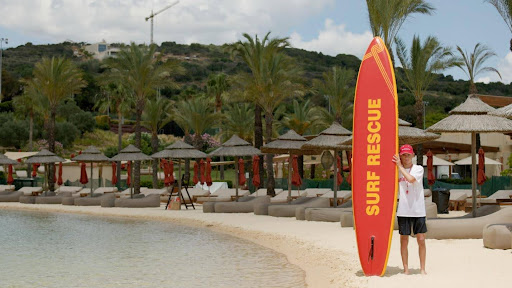There is more to being a lifeguard than simply sitting in a chair under watchful eye of an individual. This occupation is an exact mix of physical ability, intelligence, and technical skill. Lifeguards are the first responders to water emergencies (including rescues), and their readiness may be the pivotal point of life and death. There are millions of beach-goers, lake recreationalists or swimming pool users-per-year; so the demand for versatile, educated lifeguards is constantly growing.
Lifeguarding courses and lifeguard training have advanced to include a strong set of technical skills so as to satisfy these demands. These abilities are crucial not just for rescue operations but also for prevention, risk management, and managing a vast spectrum of aquatic catastrophes.
Risk Identification and Surveillance
Sharp observation forms the basis of good lifeguarding. Lifeguards are taught to be always alert and to rapidly detect symptoms of distress, weariness, or dangerous behavior. Lifeguard training teaches students scanning methods, including the 10/20 approach, by which they have to scan their whole area every 10 seconds and be ready to react in under 20 seconds.
Understanding of risk is just as crucial. By spotting dangers before they get worse—such as slick surfaces, overcrowding, or inappropriate behavior—lifeguards may intervene proactively. Technical lifeguard training enables lifeguards to evaluate behavioral and environmental risk indicators that might cause an emergency.
Techniques for Water Rescue
The most important technical expertise a lifeguard must have is perhaps water rescue. This comprises a spectrum of rescue methods, each with its own processes and physical requirements. Important water rescue methods taught in lifeguard courses include:
- Passive victim rescue: where the person is unconscious or unable to help in their rescue.
- Active victim rescue: when the swimmer is aware but in difficulty.
- Rescuing people who are sunk at the base of a body of water or a pool.
- Handling more than one person needing assistance—usually requiring difficult decision-making under duress—many victims’ rescues involve.
Every kind of rescue calls for accurate manoeuvring, the use of gear like rescue tubes or backboards, and effective team communication.
CPR and First Aid Skillfulness
First aid and cardiopulmonary resuscitation (CPR) must be thoroughly known by a complete lifeguard. Drowning cases typically call for rapid resuscitation; minutes count. Usually, lifeguard training certifies individuals in:
- Adult, child, and infant CPR
- use of automated external defibrillators (AEDs)
- Wound care and bleeding control
- Shock treatment and stabilisation
- Heat exhaustion, stroke, and allergic reaction procedures
Knowing these fields enables lifeguards to provide lifesaving treatment while awaiting emergency medical services.
Managing Spinal Injury
Particularly where diving or rough play is frequent, spinal injuries in aquatic settings raise great worry. Specialized methods for lifeguard training cover:
- Approaching and stabilizing a suspected spinal injury victim in the water
- Equipment like head immobilizers and backboards should be used here.
- Coordinating spinal injury rescues with a crew for best safety
These abilities are regularly practiced during lifeguard training to make them second nature.
Emergency Communication and Organization
In an emergency, clear, brief, and quick communication is critical. Training teaches lifeguards to:
- Utilize hand signals and whistle codes.
- Talk to superiors and other lifeguards.
- Collaborate with EMS, police, or fire rescue crews.
- Educate and direct the public during evacuations or emergencies.
Training for lifeguards guarantees that people can effectively coordinate challenging rescues and transmit vital information when under duress.
Endurance and Physical Fitness
Lifeguards must keep top physical shape. Usually including training:
- Timed swims include 300-yard continuous swims.
- Treading water over several hours
- Deep-water brick extraction
- Swimming entails dragging a victim.
- Climbing out of the pool fast without help
These physical obstacles ensure a lifeguard’s body can keep up with the demands of the job and mimic real-life crises.
Operation of Facilities And Pools
Beyond their primary job of saving lives, numerous lifeguards oversee the day-to-day management of aquatic amenities. This comprises:
- Looking at safety gear
- Keeping an eye on chemical levels and water clarity
- inspecting drainage and filtration systems
- Enforcing swimming rules and guidelines
Advanced lifeguard training often covers facility operations, therefore equipping guards to manage a larger range of duties with skill.
Management of Rescue Equipment
An expert lifeguard must be proficient with a great number of rescue and safety equipment, including:
- Rescue tubes and cans
- Throw ropes and bags.
- Devices for immobilization and spine boards
- AED units and first-aid kits
- Lifeguard towers and communication networks
Every level of lifeguard training places great importance on the technical ability to know when and how each item of equipment should be employed.
Team Leadership and Incident Reporting
Leading and reporting are also among the lifeguards’ training. Someone must take charge, allocate roles, and guarantee the rescue runs effectively during crucial events. In big venues or crowded beaches, leadership abilities are crucial. Moreover, necessary for liability, follow-up care, and preventive measures to correctly record events.
Training covers thorough instruction on witness gathering, incident reporting, and collaboration with managers or public safety personnel to correctly communicate crucial information.
Ability to Adapt in Natural Settings
Environmental adaptability is especially important for lifeguards who work on oceans, streams, or lakes. Unpredictable natural surroundings call for lifeguards ready to address:
- Wave, tide, and strong current
- Rapid alterations in weather
- Marine life
- Limited visibility and rugged terrain
Emphasizing hazard assessment and adaptive rescue methods to fit real-world situations, specialized lifeguard programs handle these factors.
Continuous Demand for Qualified Lifeguards
Never has the need for these technical abilities been greater. A national lifeguard shortage in recent years has affected the day-to-day operations of pools and beaches all across the country. According to media reports, the scarcity has obliged several companies to cut hours, close some amenities, or run under safety rules.
Often mentioned in electronic and print media for expert advice, the American Lifeguard Association has voiced alarm about the public safety hazards presented by this paucity. They stress the need for robust recruiting initiatives, improved lifeguard training, and better pay to draw and keep competent lifeguards.
Their lobbying draws attention to the constant need for lifeguards who not only fulfil minimal criteria but also shine in the broad spectrum of technical expertise needed for the position.
Last Remarks
There is a need for safety in public and private aquatic settings, so lifeguarding is a technical career that pairs leadership with fast thinking, lifesaving skills, and physical preparation. Now that is a technical profession! Learning these technical skills is nonnegotiable. The next step towards becoming a confident and capable professional is to take certified lifeguard courses where you can improve your skills or attend a leader or instructor course in lifeguarding.
If there is a genuine interest in pursuing a career as a lifeguards or improving your skills as a lifeguard, the American Lifeguard Association has nationally recognized programs that have both basic rescues skills, and presently accepted and safer emergency procedures delivered in their programs. These programs are well designed, so lifeguards will be fully trained to lead, stop, and defend as well as just react.

